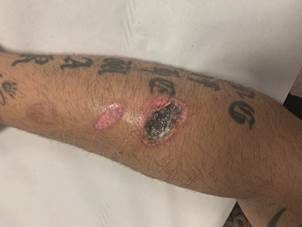There are many types of non-suicidal self-injury that require medical assistance in prisons.
The concept of non-suicidal self-injury can be defined as the act of deliberately doing harm to the body without suicidal intentions. It is a damaging way of coping with emotional pain, intense anger or frustration. Although self-injury may cause a momentary sensation of calm and reduced tension, feelings of shame or guilt and other painful emotions generally soon appear shortly afterwards.
There is no one single cause of self-injury. They are generally caused by the following factors1:
Poor ability to face up to challenges and situations that are often the consequence of an inability to healthily cope with psychological pain.
Difficulties in controlling emotions: The person finds it hard to regulate, express or understand emotions. The mixture of feelings that trigger self-injury is a complex one. Examples include feelings of uselessness, loneliness, panic, rage, guilt, rejection, self-hatred or confused sexuality.
The most common bodily locations for self-injury are the arms, legs and frontal part of the torso, but any part of the body may be used. Persons who injure themselves may use more than one method. Such behaviour is generally occasional although on many occasions the self-injury may become a long-term repetitive pattern of behaviour.
Non-suicidal self-injury is a common phenomenon in prisons due to the characteristics of the setting, which can often lead people to engage in this sort of behaviour.
There are three types of factors that can increase the risk of non-suicidal self-injury taking place:
Life problems: persons who have suffered from neglect, sexual, physical or emotional abuse; persons who have gone through traumatic processes; unstable families; young people who question their personal or sexual identity; etc.
Mental health problems: persons with certain disorders such as borderline personality disorder, depression, anxiety disorders, post-traumatic stress disorder, eating disorders, etc.
Substance abuse: persons who often injure themselves while under the influence of recreational substances.
Different types of unusual non-suicidal self-injury in prison have been described and published. These include piercing the skin with screws2 and nails3, the insertion of sharp metal objects under the skin (called “missiles” in Spanish prison jargon)4 sewing up the lips5-6 or even the eyelids as a form of protest7, swallowing metal objects such as springs, razor blades or even nail cutters8, and burning the skin as shown in Figure 1.
But there is a type of non-suicidal self-injury that stands out from the others. It consists of cuts or “chinazos”, as they are called by inmates, and can compromise the dermis. Examples can be seen in Figures 2 and 3.
Sometimes they are simple scratches, in the form of words or signs with a strong emotional content, as shown in Figure 4, where the person makes a silent plea for help. It is often a way to communicate internal feelings of depression or distress.
We should not neglect the need to act in situations of non-suicidal self-injury regardless of whether cause is compulsive or impulsive.
It is important to identify the patient's motives, since he/she can act as a guide in treating and preventing non-suicidal self-injury. Treatment might commence with ways to cope with negative feelings via therapies that focus on regulating emotions, followed by considering the most prominent inter-personal factors, with a focus on therapies to develop effective interpersonal skills and alternative ways to react to interpersonal situations that might lead to self-injury.
Any intervention that encourages management of experiences such as negative emotions will greatly contribute towards preventing non-suicidal self-injury, which only lead to considerable emotional distress in patients.


















